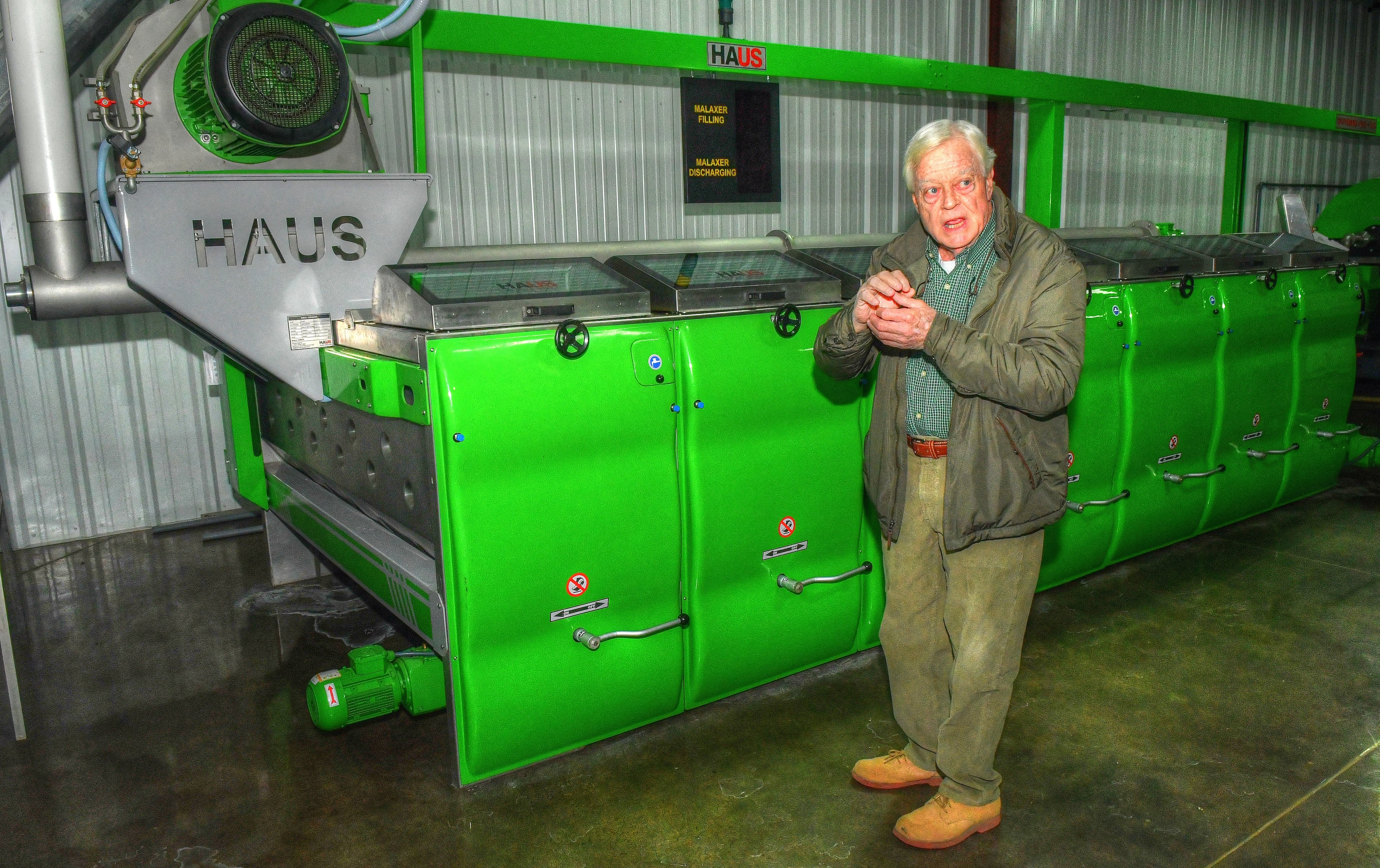How a family farm in South Georgia became a thriving olive-oil enterprise

BROOKS COUNTY, GEORGIA — Cooley Hobdy grew up on a farm in southern Mississippi, where his daddy planted corn and cotton and worked “on the side” as postmaster for the town of Waynesboro. As a young man, Hobdy had little interest in farming, however. He considered pre-med but felt that being a doctor, while noble, wouldn’t offer much in the way of entrepreneurship. Pharmacy, on the other hand, would position him to run a drug store, keep up with town gossip and perhaps make a few business deals.
“When I was young, if you put a rabbit in front of me, I’d chase it,” said Hobdy, now 74.
After earning his pharmacy degree from Ole Miss, Hobdy struck out for Valdosta. “I had kin people here, and I just always loved this place,” he said of the South Georgia town known for its bountiful agriculture, dazzling azaleas, ferociously competitive high-school football team, well-regarded public university (Valdosta State), and proximity to Florida, which sits right across the county line.
By the time Hobdy was 30, he owned two drugstores. Since then, he has bought and sold so many businesses — a total of 13 — that he strains to remember them all. There was a payroll firm, a logging outfit, a home health-care equipment business and, since 1987, MIDS Transportation Inc., a rural transportation company that operates a fleet of about 100 vehicles in 24 Georgia counties.
Hobdy’s latest passion is olives.
We’re not talking about the two bushes his wife, Debbie, bought for $38 at Lowe’s and planted by their Valdosta driveway. We’re referring to the family’s 60,000 arbequina trees situated in picture-perfect rows on 100 acres of gently undulating orchards.
Vacationing in the San Francisco Bay area in 2013, Hobdy was less enamored of the grape than of the region’s compact olive trees. Being a pharmacist, he was already well-schooled in the health benefits of olive oil, the core ingredient of the Mediterranean diet. It also appealed to his agricultural background.

Six miles outside Valdosta in Quitman, the Hobdys owned a plot of land, a pastoral setting with cows, horses and fish ponds. They’d been using it for family recreation, but their two sons had outgrown it, and Hobdy was tired of tending it and spending money on it. Maybe he could strike oil, extra virgin, that is.
“I told Debbie, I said, ‘Debbie! We are not doing anything with that farm. Let’s make a farm out of it.’ ”
After clearing the land, Olive Orchards of Georgia planted its first trees in spring 2014. “Lord, we ordered trees, until I couldn’t order no more,” Hobdy recalled. But Mother Nature played a dirty trick: The famously brutal winter of 2015 killed about half of them. “One thing about olives, they can stand freeze, but they can’t stand two days of it, back to back,” Hobdy said.
So they started over, planted new stock in 2015, and harvested their first crop in 2018. The payoff was immediate: Olive Orchards of Georgia’s American extra virgin olive oil, first cold pressed, won the University of Georgia’s 2019 Flavor of Georgia Food Product Contest, in the miscellaneous category.
“This started out as a hobby,” Hobdy told me as he wheeled his massive Chevy 2500 diesel pickup through the front gate of his impeccably manicured olive farm. “It grew in a hurry not to be a hobby.”
One look around the place — at the pair of harvesters imported from France; the state-of-the-art mill; the bottling and packing plant; the cottage-style office with its perfect shade of dark-green shutters — and you have to believe this gentleman with the gravelly Southern drawl and the perfectly coordinated olive-green outfit.
It took decades, but Cooley Hobdy finally made his way back to farming, on land that once belonged to his mother’s people.

High demand yields instant success
Hobdy remembers a slower, gentler time when people used No. 2 pencils instead of computers, kids made Christmas lists based on Sears, Roebuck catalogs, and his Southern mama cooked with Crisco, never olive oil.
But the world has changed since he was a boy.
Americans consume 90 million gallons of olive oil annually, and the industry is growing. “I take a tablespoon every morning and night for my health,” he says. “Fifteen ccs,” he added, as if remembering he’s a pharmacist. Naturally, he medicates with his own arbequina olive oil, which he describes as smooth, buttery and easy on the palate.
For the most part, Southeastern olive growers stick to three cultivars: the luscious arbequina, the peppery arbosana and the spicy koroneiki. Hobdy picked arbequina because “it’s the most suitable for the weather.”
Climate has everything to do with the success of the species known as Olea europaea. Think of windswept Mediterranean hillsides with gnarly trees shaped by time. Olives thrive in well-drained soil and warm temperatures, but they do need cool nights — what growers call chill hours. In the Southeast, that line extends from below Macon down to Savannah and into South Carolina, a swath the USDA’s plant hardiness map refers to as zone 8b.
“If it will stay cold through March, we’ll have a big crop,” Hobdy said. “If you can put a pair of shorts on at the end of February, you ain’t going to have doodle-crap.”

Spanish settlers are said to have planted olive trees at missions along the Georgia coast as early as the 1590s. When Oglethorpe landed in Savannah in 1733, he encouraged settlers to grow the silver-green trees with little success. Jefferson encountered them in France and had them shipped to Georgia and South Carolina, but they never took root.
According to an Olive Oil Times article from 2012, Georgians began to investigate the possibility of growing olives in 2000, in part because of a devastating drought. Farmers needed something that could withstand the stress. Around the same time, Georgia blueberry growers became intrigued by the prospect of olives, because they could use their harvesters to pick a fall crop.
By 2011, Georgia Olive Farms in nearby Lakeland had harvested the first commercial crop of olives grown east of the Mississippi since the 1800s. Since then, Georgia farms big and small have taken a shot at the crop. Vicki Hughes, executive director of the Georgia Olive Growers Association, said Georgia has 16 olive farms, plus a few more under 5 acres.
Today, with 6,000 acres in cultivation, Georgia is second only to California, which has four times the acreage.
“We are averaging here on a good year 2,000 gallons, which will produce us 30,000 (250 ml) bottles,” Hobdy said.
To put that in perspective, the U.S. produced 1.9 million gallons of olive oil in 2020, the American Olive Oil Producers Association in Fresno, California, reports, adding that the 2021 figure is expected to be slightly higher. Numbers on Georgia’s recent yields are not available.

Debbie Hobdy has been instrumental in promoting the Olive Orchards of Georgia brand, traveling to trade shows and cultivating accounts. When she unveiled the first bottling at AmericasMart Atlanta in 2019, vendors were all over it. “We have probably 150-something dealers now,” Cooley said. Then COVID hit, and the push was off.
But digital sales soared. “We sell a ton of that olive oil,” Hobdy said. “We have shipments go out every day.”
This year, the 2020 bottling sold out just as the new crop came in. “You can’t produce enough olive oil in Georgia to fill the orders,” Hobdy said. “That’s your biggest fear — of running out.”
That sort of demand means that the outlook for the industry is good. American-grown olive oil accounts for only 6% of the nation’s annual intake. The rest comes from overseas.

Ancient process goes high-tech
At Olive Orchards, the harvest generally begins in October and continues for a frantic three or four weeks. Hobdy drives one of the harvesters. “I get on at 7 and don’t get off til 7,” he said. During peak season, the farm hires a local crew to help out.
Extracting oil from olives is an ancient process, but thanks to modern technology, it’s gone from elemental to high-tech. “This is the largest mill east of the California state line,” said Hobdy, as he explained how the fresh picked fruit runs through the assembly line of expensive, German-manufactured machines. The hopper sucks out leaves and debris and shoots the refuse outside the building. The “washing machine” bathes the olives in fresh water, and the hammer mill smashes and pits them. The malaxers render them into a paste, the decanter separates the solids from the liquid, and the centrifuge refines the oil. Once filtered, the liquid gold is stored in 1,200-gallon stainless-steel tanks.
“As long as that oil doesn’t have light, oxygen, and it’s the right temperature (about 70 degrees), it lasts forever,” Hobdy said.

Sam Smith, who played high-school football with the Hobdys’ oldest son, is the farm manager. When Hobdy announced he was going full olive, back in 2013, “I thought that was crazy as hell,” said Smith, 40.
Now it’s like that virgin oil has seeped into his soul. Those trees are his babies. He also runs the mill, bottles the oil, applies the labels and handles the shipping.
“I love it,” said Smith, who studied culinary arts after high school and dreams of having a side gig of his own: a food truck that caters to farm workers, who often have to drive miles to find something to eat.
Smith’s job description doesn’t include recipe development or public relations, but after hearing him enthuse about cooking with the farm’s signature product, maybe it should.
He uses it to make fried rice. He puts it in pasta sauce and drizzles it over pasta salad. And when it comes to grilling, it’s his secret weapon, great for marinades and pouring over veggies. Like his boss, Smith and his wife take a tablespoon each, twice a day. “I can talk for days about that olive oil, what I use it for.”
While Cooley and Sam handle the orchards, the Hobdys’ sons, John and Joshua, keep an eye on the transportation business in town. “They know that the bread and butter is up there,” said Hobdy. “In a few years, when we get some time, this might be the bread and butter.”
For more information about Olive Orchards of Georgia, visit oliveorchardsofgeorgia.com. Find more stories about Georgia farmers and recipes for their products at ajc.com/georgia-on-my-plate.

